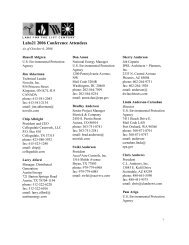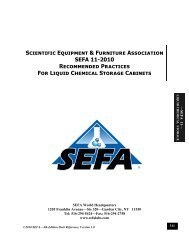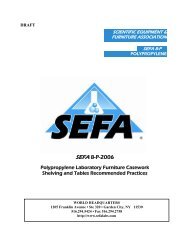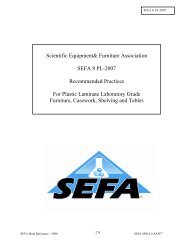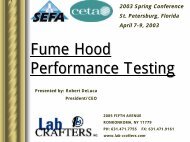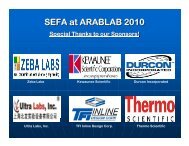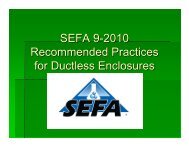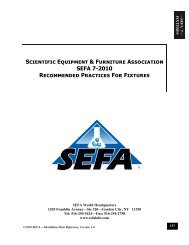Download SEFA-9-2010-Ductless.pdf - Scientific Equipment and ...
Download SEFA-9-2010-Ductless.pdf - Scientific Equipment and ...
Download SEFA-9-2010-Ductless.pdf - Scientific Equipment and ...
- No tags were found...
Create successful ePaper yourself
Turn your PDF publications into a flip-book with our unique Google optimized e-Paper software.
EH&S officer.<br />
4.2.4 Face Velocity Monitoring DH II / III<br />
A permanent face velocity monitoring device<br />
should be incorporated within all DH II <strong>and</strong> III<br />
ductless hoods. The monitoring device should<br />
be calibrated by a face velocity traverse as recommended<br />
in ASHRAE 110-95 using the average<br />
as the set point. To ensure proper performance<br />
as recommended by the manufacturer testing<br />
should be performed at least annually.<br />
4.3 <strong>SEFA</strong> 9 Benchmark Testing –<br />
As Manufactured<br />
4.3.1 Filtration <strong>and</strong> Containment<br />
DH I:<br />
Nuisance odors only. No testing required.<br />
DH II <strong>and</strong> III:<br />
If manufacturers require more than one filter<br />
media type to perform the benchmark test<br />
chemicals, testing should then be performed<br />
using the appropriate filter media type.<br />
Benchmark - Testing procedure:<br />
This test is applicable to only Class II <strong>and</strong><br />
Class III hoods. It is not intended for Class I<br />
type hoods used for nuisance <strong>and</strong> non toxic<br />
odors<br />
Calibration of testing equipment— please refer<br />
to ASHRAE 110-95 for calibration guidelines.<br />
Hood setup <strong>and</strong> face velocity measurements—<br />
the ductless hood shall be setup per manufacturer’s<br />
recommendations in a location that has<br />
average cross draft of less than 30 fpm when<br />
measured 18 inches out from the face of the<br />
hood at the left <strong>and</strong> right side of the sash opening.<br />
Face velocity measurements are made by<br />
establishing an imaginary grid pattern equally<br />
divided in the vertical <strong>and</strong> horizontal positions<br />
<strong>and</strong> taking velocity readings at each grid point.<br />
Readings should be taken each second for a<br />
period of 30 seconds <strong>and</strong> averaged. Determine<br />
the average of each grid position. The measured<br />
deviation shall not vary more than +/-<br />
20% of the overall average. Cross draft <strong>and</strong><br />
airflow velocity measurements are made using<br />
a hot wire calibrated anemometer. Test each<br />
model (Type Test) or after modification to unit<br />
or filter. The hood face velocity shall be set by<br />
the ductless hood manufacturer. (Refer to<br />
<strong>SEFA</strong> 1-<strong>2010</strong> Section 4.3 <strong>and</strong>/or ANSI/<br />
ASHRAE 110-1995 6.2 Face Velocity Measurements<br />
or most curent version).<br />
Flow Visualization — discharge smoke from a<br />
smoke stick along the walls <strong>and</strong> work surface<br />
of the hood six inches back from the front of<br />
the unit. Smoke shall be carried to the back or<br />
top of the hood <strong>and</strong> be exhausted with little<br />
reverse movement. Particular attention shall be<br />
given to the corners. At no time shall smoke<br />
escape out the hood, except through the filtered<br />
exhaust. If smoke does escape out the front of<br />
the hood the hood fails the test. The filter seals<br />
<strong>and</strong> other areas of the hood where contaminate<br />
could escape shall be under negative pressure.<br />
Containment Testing. (Refer to ASHRAE 110-<br />
1995 or most current version for specific details.)<br />
— place an exhaust duct with canopy<br />
style connection from an exhaust system with<br />
variable control over the exhaust port of the<br />
ductless hood. The exhaust system shall be set<br />
to exhaust a greater CFM than the ductless<br />
hood requires to keep any contaminates from<br />
the exhaust from leaking into the test room.<br />
Once the external exhaust system is operating,<br />
face velocity readings shall be retaken <strong>and</strong><br />
match those previously taken with the external<br />
exhaust system off. If the face velocities have<br />
changed, reduce the exhaust system CFM to<br />
where there is no effect on the hood face velocities.<br />
The exhaust on the system must be<br />
great enough to keep the exhaust plenum area<br />
negative, but not so strong that the face velocities<br />
on the hood are affected.<br />
Use an ITI Leak Meter or other continuous<br />
reading instrument specific for sulfur<br />
hexafluoride gas capable of 0.01 ppm detection<br />
or less.<br />
—<strong>SEFA</strong> 9—<br />
DUCTLESS<br />
©<strong>2010</strong> <strong>SEFA</strong>—4th Edition Desk Reference, Version 1.0 303



